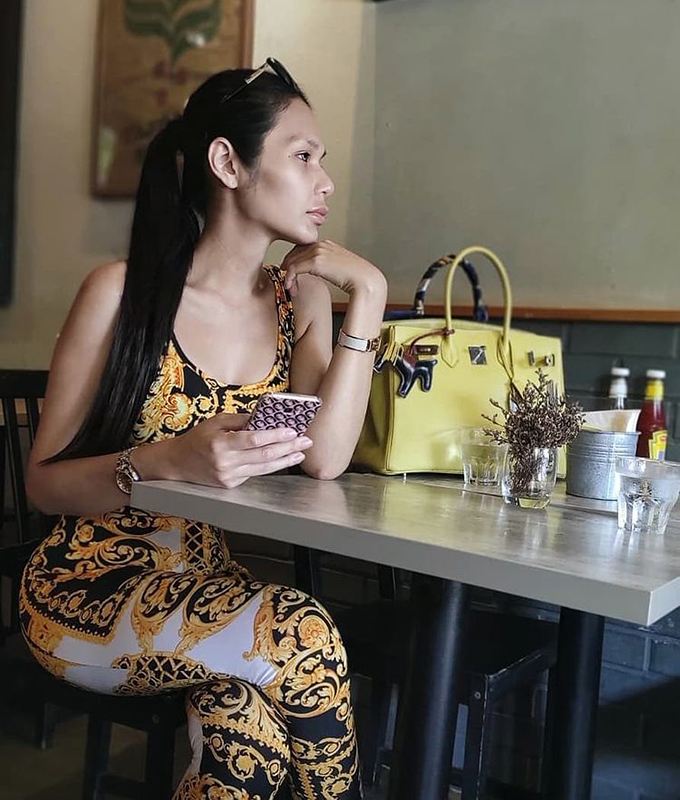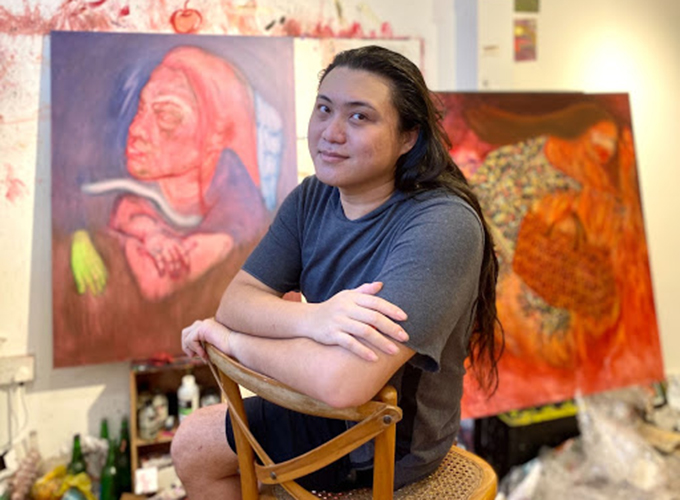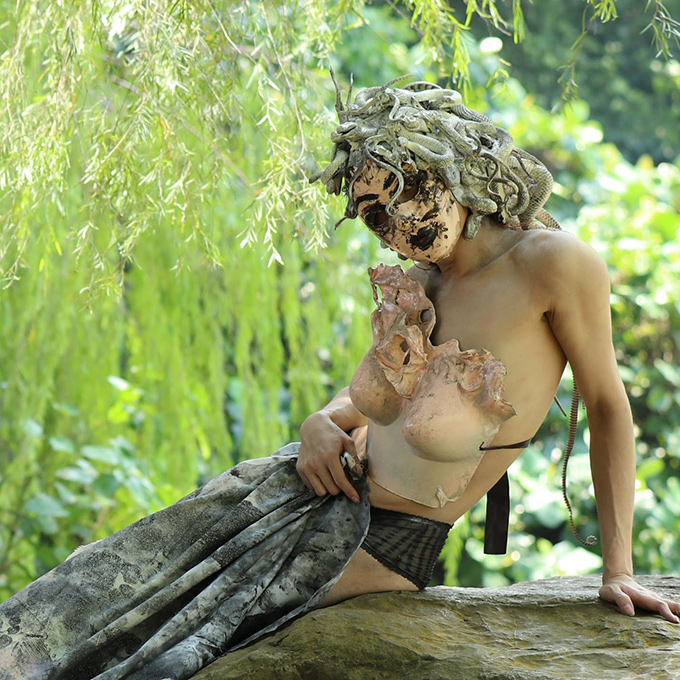There is a domain of psychology called the “psychology of dress”—a term first coined by American clinical psychologist Dr Jennifer Baumgartner. In her book You Are What You Wear: What Your Clothes Reveal About You, she asserts that the way we choose to attire ourselves reveals much about the way we wish to be perceived and our inner unresolved conflicts. And that is certainly the case for these three transgender Singaporeans: model Andrea Razali (she/her), artist Marla Bendini (she/they), and musician Cayes Hotwheels Hong (he/they).
At different stages in their lives, fashion has meant different things to them: as armour; as something to hide behind; as self-expression; or as a way of reclaiming their dignity. Vogue Singapore speaks to Razali, Bendini, and Hong to find out the role fashion played in their journey of gender exploration. One thing is clear across all three stories: this journey is an ongoing one.
Andrea Razali (she/her), model and beauty pageant queen

I knew I was very feminine from as young as age 5. I started playing with my mum’s clothes and heels when she wasn’t home. She had this pink tennis skirt; after I transitioned, I bought that same style of skirt in different colours because that article of clothing made such a strong impression on me. In fact, for the first two years after my transition, my go-to outfit was that tennis skirt with a tank top.
When I was doing National Service (NS), I had to present myself in a very masculine way. I was also judged at home for wanting to wear androgynous or feminine clothing. To avoid criticism, all I wore was long-sleeved shirts, straight-cut jeans, and sneakers. It almost felt like I was wearing a uniform. I felt so depressed, because I love fashion and I love dressing up. I think that’s why I have a lot of clothes now, because I want to give myself the privilege of dressing however I want.
After I finished NS, I grew my hair out until it was chest-length and started shopping only in the women’s section. I would wear ladies’ suits, floral prints, and curve-hugging items like skinny jeans. My guy friends would be carrying their canvas backpacks and I would be holding my lambskin Chanel. It was very difficult because a lot of people, even my friends, would make fun of me. They would say, “You’re a guy but you’re wearing such sexy clothing and carrying female handbags.” It took around two years of pushing the boundaries of my dressing before I started taking hormone pills when I was 23.

Now, I finally feel comfortable in my own skin. My body is my best accessory, so I try not to hide too much of it. I make sure my clothes are tight-fitting and tailored so that even when I’m covered up, they still show my figure. And if I do wear loose garments, like maxi dresses, they always have loud prints so that I catch people’s eye. I think it’s to compensate for all the years I spent hiding my true self behind clothes I don’t feel for. I’m not a shirt-and-shorts girl at all. Even when I’m at home, I wear a body-hugging t-shirt dress. Fashion is how I express my femininity, so I avoid masculine clothing.
I like how nowadays, women have more options to dress in more masculine ways—big brands like Gucci, Prada, and Chanel are using more gender-neutral cuts in their clothing. Men are also allowed to be more feminine. I see make-up for men and more men unafraid to rock the colour pink. It’s not easy erasing the effects of toxic masculinity and we should give men the space to be more comfortable with their feminine side.
Cayes Hotwheels Hong (they/he), musician

I never had a “eureka” moment where how I perceived myself changed 180 degrees overnight. I realised I was trans around the same time any cis person realises they’re cis. Most of my early life was spent battling my internalised transphobia and coming to terms with my trans-ness. It takes a lot of self-assuredness to be trans. Your inner voice has to be one you trust and one that is louder than all the external transphobia you’ll encounter.
Even as a young child, I always leaned towards dressing in a more typically masculine way. My parents would even bribe me to wear female-coded clothing like dresses to family events. I spent a year in a co-ed school and often got sentenced to detention because I would keep showing up in my PE (physical education) attire. Once, I managed to get my hands on a hand-me-down boys’ uniform and wore it to school, but I was instructed within an hour to change out.
When I was 14, I got my first binder. I remember feeling so liberated that I no longer had to constantly hunch over or wear a hoodie in the heat. Binding offered me the freedom to dress more like how I wanted instead of according to what would best alleviate my dysphoria. The first time I wore a plain white shirt since primary school was after my top surgery (male chest reconstruction) in 2019. Before that, I avoided clothes that were plain white, tight-fitting or made of thin fabric because my binder would be visible. I also avoided wearing anything that could possibly be coded as feminine in a bid to try to reduce my likelihood of being misgendered.

The outfit choices that I make on a daily basis depend almost entirely on how dysphoric I feel on that particular day. Fashion to me is a way of reflecting my headspace externally, so my mental state and how good I’m feeling about myself directly translate to what I wear: I look good when I feel good. Otherwise, my wallet is my second biggest limitation—I’ve outgrown a lot of my wardrobe, but haven’t been able to afford updating my clothing options.
Being visibly out as trans in public can be a minefield, and some days, I just don’t have the energy to always be in defence mode. I love heels, crop tops, and high-waisted pants, but it takes so much energy to ignore the stares that come with wearing these “female” garments as a man, so they sit mostly untouched in my wardrobe. I still sometimes feel the need to dress in a way that would lead people to assume I’m cisgender—it’s a bit tricky toeing the line between presenting myself authentically and protecting myself from unwanted attention.
Marla Bendini (she/they), artist

Growing up, I always sensed that I was different; that there were parts of me I had to hide from others and even from myself. But it was only when I was 21 that I made the decision to transition. I’ve faced a lot of discrimination and rejection for making people feel uncomfortable, but people don’t realise this discomfort goes both ways. I too had to get used to receiving negative attention and even outright aggression, and it took a lot of time to start feeling comfortable in my body.
My first pair of women’s shoes came from a shop in Tanjong Pagar. Back in 2006, it was one of the only places in Singapore that customised larger shoes for trans women and cross-dressing men. I bought a pair of pumps, and paired them with a sheer top and Zara trousers. I walked down Orchard Road in this outfit and my feet were numb by the end, but it was so worth it. For the first time, I felt seen for who I really was; no one could look away from me and it felt like I was on stage wherever I went.
People criticized the way I dressed for being quite aggressive and loud. They would say, “Why do we have to look at you dressed like that? Do you have no shame?” But they didn’t realise that fashion is like my armour. There were (and still are) a lot of people who made me feel like a lesser being, even my own family, but I couldn’t confront them about it. So the way I dressed was my way of fighting back and expressing all the things I wished I could say. Even today, I think of fashion as my voice; as the one thing that I can control and others can’t censor, it gives me back my dignity.

Being perceived as sexy and feminine gave me a certain relief from my body and gender dysmorphia, but it also wasn’t the complete answer for me. So at some point, I started experimenting with dressing up as mythical beings, like Medusa and Lady White Snake. These costumes allowed me to inhabit different personas, and doing so made me feel protected and empowered. Singapore’s fashion industry has come a long way in terms of trans inclusivity, but we are still not in the mainstream consciousness. So, I dressed flamboyantly in order to amplify that consciousness.
Some people thought that because I dressed in such a visible manner, it was okay to treat me as an open target for abuse. There were times I feared for my personal safety. I felt so tired of dealing with homophobia and transphobia that, three years ago, I started the process of de-transitioning. For a long time, I felt guilty about my decision. I thought I was disappointing everyone who viewed me as a role model. But I realised no one ever demanded that of me except myself, and it’s more important that I remain authentic to what I want and no longer want. I find myself apologising for not looking a certain way anymore, but my friends tell me: “You’re still you. However you want to dress and express yourself, everything is within your control and your choice.”
These days, I’m learning how to dress down without feeling like I’m compromising who I am. De-transitioning feels like a more internal, spiritual process for me, so what I wear on the outside doesn’t really matter to me anymore. Back when I identified as a trans woman, I didn’t feel comfortable wearing a shirt and jeans because I felt like gender-neutral garments amplified the parts of me I didn’t like; I didn’t feel feminine enough wearing them. But now, I no longer have to rely on clothes to feel feminine because I know the core of my identity comes from somewhere deep within myself. My style is less hardcore and more normcore, and I can feel like myself even in a simple tank top and shorts. Members of the LGBTQ+ community always have to fight our battles hard. We might seem strong and loud, but I think it’s so refreshing and precious to be able to scale things back and still own who I am.





